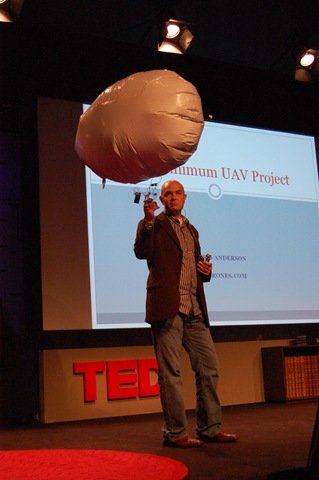
TED BlimpBot Report: Foiled by Air Conditioning!
Chris Anderson
The Long Tail
March 01, 2008
[This is a cross-post from my other blog at DIY Drones [ http://diydrones.com/ ], where among other things we've been developing an under-$100 autonomous blimp for aerial robotics contests]

Yesterday my UAV partner Jordi (a 21-year-old embedded programming whiz who just emigrated from Mexico) drove up with the BlimpBot to Monterey, where I was attending the TED conference [ http://www.ted.com/index.php ]. I had a three-minute slot to show how the prototype works. This was a pretty high-stake demo, since not only would there be 2,000 of the most influential people in the technology, entertainment and design (TED) worlds watching, but they included Al Gore in the FRONT ROW, Google's Sergey Brin and Larry Page and movie stars such as John Cusack and Goldie Hawn.
The bot worked great in the hotel room, and then we took it the the auditorium
during a break to test it on the main stage. Yikes. We were getting IR interference
from everything, from LCD screens to the bright stage lights, and our reception
range dropped to something around three feet. Even worse, the air currents were
overcoming the blimp's ability to fight them. So we gave up on the idea of a fixed
IR beacon on the ground, and I decided to hold it in my hand to keep it near the
blimp. Even then, the motors couldn't fight the currents well enough.
So we rushed
back to our staging area (my hotel room) and Jordi updated the firmware to give
more power to the motors even at the cost of battery life (this demo only had to
run three minutes) . We tested it again in the hotel room, it worked fine, and then
it was time to go.
When we got to auditorium and waited in the wings to go on, it was clear that something bad had happened in the firmware update. The vertical motor wasn't coming on at all sometimes and it wasn't clear why. Then Jordi realized that in changing the power settings,he'd also changed the timing of the loops, and we weren't resetting the motor controllers at the right time, which meant that the chance of them being working when needed was random (and low). We'd just been lucky in the hotel room, but clearly weren't now. Still, I crossed my fingers and went on, carrying the blimp.
Disaster! It turns out that one big thing had changed since our test run in the auditorium: 600 people had arrived. All that body heat had raised the temperature of the room, kicking in the air conditioning, which came out of huge ducts right over the stage. Basically I was under a raging waterfall of cold air, and the poor blimp sank right to the floor, its little vertical thruster completely overcome.
[Photo credit: Red Maxwell]
Copyright 2008 http://www.thelongtail.com/